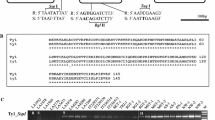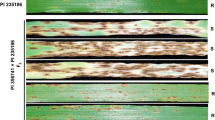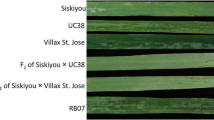Abstract
The RXopJ4 resistance locus from the wild accession Solanum pennellii (Sp) LA716 confers resistance to bacterial spot disease of tomato (S. lycopersicum, Sl) caused by Xanthomonas perforans (Xp). RXopJ4 resistance depends on recognition of the pathogen type III effector protein XopJ4. We used a collection of Sp introgression lines (ILs) to narrow the RXopJ4 locus to a 4.2-Mb segment on the long arm of chromosome 6, encompassed by the ILs 6-2 and 6-2-2. We then adapted or developed a collection of 14 molecular markers to map on a segregating F2 population from a cross between the susceptible parent Sl FL8000 and the resistant parent RXopJ4 8000 OC7. In the F2 population, a 190-kb segment between the markers J350 and J352 cosegregated with resistance. This fine mapping will enable both the identification of candidate genes and the detection of resistant plants using cosegregating markers. The RXopJ4 resistance gene(s), in combination with other recently characterized genes and a quantitative trait locus (QTL) for bacterial spot disease resistance, will likely be an effective tool for the development of durable resistance in cultivated tomato.





Similar content being viewed by others
References
Astua-Monge G, Minsavage GV, Stall RE, Vallejos CE, Davis MJ, Jones JB (2000) Xv4-vrxv4: a new gene-for-gene interaction identified between Xanthomonas campestris pv. vesicatoria race T3 and wild tomato relative Lycopersicon pennellii. Mol Plant Microbe Interact 13:1346–1355
Bart R, Cohn M, Kassen A, McCallum EJ, Shybut M, Petriello A, Krasileva K, Dahlbeck D, Medina C, Alicai T et al (2012) PNAS Plus: High-throughput genomic sequencing of cassava bacterial blight strains identifies conserved effectors to target for durable resistance. Proc Natl Acad Sci USA. doi:10.1073/pnas.1208003109
Bombarely A, Menda N, Tecle IY, Buels RM, Strickler S, Fischer-York T, Pujar A, Leto J, Gosselin J, Mueller LA (2011) The Sol Genomics Network (solgenomics.net): growing tomatoes using Perl. Nucleic Acids Res 39:D1149–D1155
Canady MA, Ji Y, Chetelat RT (2006) Homeologous recombination in Solanum lycopersicoides introgression lines of cultivated tomato. Genetics 174:1775–1788
Eshed Y, Zamir D (1994) A genomic library of Lycopersicon pennellii in L. esculentum: a tool for fine mapping of genes. Euphytica 79:175–179
Fulton TM, Van der Hoeven R, Eannetta NT, Tanksley SD (2002) Identification, analysis, and utilization of conserved ortholog set markers for comparative genomics in higher plants. Plant Cell 14:1457–1467
Geethanjali S, Chen K-Y, Pastrana DV, Wang J-F (2010) Development and characterization of tomato SSR markers from genomic sequences of anchored BAC clones on chromosome 6. Euphytica 173:85–97
Glades Crop Care (1999) Crop profiles for south Florida tomatoes. http://www.gladescropcare.com/CP_tomatoes.pdf:1-24. Accessed 11 June 2012
Hert AP, Roberts PD, Momol MT, Minsavage GV, Tudor-Nelson SM, Jones JB (2005) Relative importance of bacteriocin-like genes in antagonism of Xanthomonas perforans tomato race 3 to Xanthomonas euvesicatoria tomato race 1 strains. Appl Environ Microbiol 71:3581–3588
Hutton SF, Scott JW, Yang W, Sim S-C, Francis DM, Jones JB (2010) Identification of QTL associated with resistance to bacterial spot race T4 in tomato. Theor Appl Genet 121:1275–1287
Jones JDG, Dangl JL (2006) The plant immune system. Nature 444:323–329
Jones JB, Bouzar H, Somodi GC, Stall RE, Pernezny K, El-Morsy G, Scott JW (1998) Evidence for the preemptive nature of tomato race 3 of Xanthomonas campestris pv. vesicatoria in Florida. Phytopathology 88:33–38
Jones JB, Lacy GH, Bouzar H, Stall RE, Schaad NW (2004) Reclassification of the xanthomonads associated with bacterial spot disease of tomato and pepper. Syst Appl Microbiol 27:755–762
Jones JB, Lacy G, Bouzar H, Minsavage G, Stall R, Schaad N (2005) Bacterial spot: worldwide distribution, importance and review. Acta Hort 695:27–33
Kearney B, Staskawicz BJ (1990) Widespread distribution and fitness contribution of Xanthomonas campestris avirulence gene avrBs2. Nature 346:385–386
Lewis RS, Linger LR, Wolff MF, Wernsman EA (2007) The negative influence of N-mediated TMV resistance on yield in tobacco: linkage drag versus pleiotropy. Theor Appl Genet 115:169–178
Obradovic A, Jones JB, Balogh B, Momol MT (2008) Integrated management of tomato bacterial spot. In: Ciancio A, Mukerji KG (eds) Integrated management of diseases caused by fungi, phytoplasma and bacteria. Springer Science+Business Media, Dordrecht, pp 211–223
Pei C, Wang H, Zhang J, Wang Y, Francis DM, Yang W (2011) Fine mapping and analysis of a candidate gene in tomato accession PI128216 conferring hypersensitive resistance to bacterial spot race T3. Theor Appl Genet. doi:10.1007/s00122-011-1726-1
Potnis N, Krasileva K, Chow V, Almeida NF, Patil PB, Ryan RP, Sharlach M, Behlau F, Dow JM, Momol M et al (2011) Comparative genomics reveals diversity among xanthomonads infecting tomato and pepper. BMC Genomics 12:146
Robbins MD, Darrigues A, Sim S-C, Masud MAT, Francis DM (2009) Characterization of hypersensitive resistance to bacterial spot race T3 (Xanthomonas perforans) from tomato accession PI 128216. Phytopathology 99:1037–1044
Roden J, Eardley L, Hotson A, Cao Y, Mudgett MB (2004) Characterization of the Xanthomonas AvrXv4 effector, a SUMO protease translocated into plant cells. Mol Plant Microbe Interact 17:633–643
Sato S, Tabata S, Hirakawa H, Asamizu E, Shirasawa K, Isobe S, Kaneko T, Nakamura Y, Shibata D, Aoki K et al (2012) The tomato genome sequence provides insights into fleshy fruit evolution. Nature 485:635–641
Stall R, Jones J, Minsavage G (2009) Durability of resistance in tomato and pepper to xanthomonads causing bacterial spot. Annu Rev Phytopathol 47:265–284
Tai T, Dahlbeck D, Clark ET, Gajiwala P, Pasion R, Whalen MC, Stall RE, Staskawicz BJ (1999) Expression of the Bs2 pepper gene confers resistance to bacterial spot disease in tomato. Proc Natl Acad Sci USA 96:14153–14158
Tanksley SD, Ganal MW, Prince JP, de Vicente MC, Bonierbale MW, Broun P, Fulton TM, Giovannoni JJ, Grandillo S, Martin GB (1992) High density molecular linkage maps of the tomato and potato genomes. Genetics 132:1141–1160
Wang H, Hutton SF, Robbins MD, Sim S-C, Scott JW, Yang W, Jones JB, Francis DM (2011) Molecular mapping of hypersensitive resistance from tomato ‘Hawaii 7981’ to Xanthomonas perforans race T3. Phytopathology 101:1217–1223
Zhao B, Dahlbeck D, Krasileva KV, Fong RW, Staskawicz BJ (2011) Computational and biochemical analysis of the Xanthomonas effector AvrBs2 and its role in the modulation of Xanthomonas type three effector delivery. PLoS Pathog 7:e1002408
Acknowledgments
We thank R. Bart and S. Goritschnig for critical reading of the manuscript. This research was supported by the Two Blades Foundation and a National Science Foundation Graduate Research Fellowship (Awarded to M.S.).
Author information
Authors and Affiliations
Corresponding authors
Additional information
Communicated by M. Havey.
Electronic supplementary material
Below is the link to the electronic supplementary material.
Rights and permissions
About this article
Cite this article
Sharlach, M., Dahlbeck, D., Liu, L. et al. Fine genetic mapping of RXopJ4, a bacterial spot disease resistance locus from Solanum pennellii LA716. Theor Appl Genet 126, 601–609 (2013). https://doi.org/10.1007/s00122-012-2004-6
Received:
Accepted:
Published:
Issue Date:
DOI: https://doi.org/10.1007/s00122-012-2004-6




